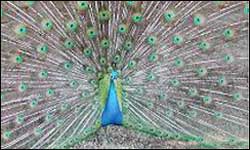Behavioural ecologists elucidated how peahens choose their mates, and why

A peacock displaying his ocelli
Since Darwin, the peacock exhibiting an elongated tail composed of ocelli has been considered a prime example of the strength of sexual selection. Professor Marion Petrie’s classical studies have shown that females prefer males with a high number of ocelli. However, a remaining question concerning the role played by ocelli is how peahens value their number. New research published today in Ethology describes that females may actually assess ocelli density.
Adeline Loyau, Michel Saint Jalme and Gabriele Sorci of the National Museum of Natural History and the Laboratory of Evolutive Parasitology, Paris, have been studying sexual selection on free-ranging common peafowl to elucidate how females choose their mate. They took pictures of displaying peacocks to count the number of ocelli, and captured them to measure tail length. They also made behavioural observations to value male displaying activity and male mating success.
“Preferred males were those exhibiting the higher number of ocelli in the train, but surprisingly females seemed to prefer males with shorter tails. This was unpredictable because we also found that the longer the train, the more dominant the male,” they say. The female preference for both high number of ocelli and shorter tail gave the idea that females may actually prefer the visual perception of a dense cluster of ocelli than a diluted number of ocelli over a large surface. “We calculated the ocelli density and found that it did explain female choice.”
In the peacock, the ocelli density of the train can only be assessed by females when males spread their trains during the courtship display. “In this species, the expression of the ornament is modulated by the expression of the behaviour. To be chosen, a peacock has to be beautiful but also has to be able to show how beautiful he is. It is not surprising that female preference is also driven by male behaviour.” Indeed, they showed that male success was determined by both his ocelli density and his displaying activity. They investigated this preference further and demonstrated that these two cues provide peahens with information about male health. “In other words, it’s beneficial for a female to mate with handsome and sportive mates,” they conclude with humour, “because these males are in better health.”
Media Contact
More Information:
http://www.blackwellpublishing.comAll latest news from the category: Ecology, The Environment and Conservation
This complex theme deals primarily with interactions between organisms and the environmental factors that impact them, but to a greater extent between individual inanimate environmental factors.
innovations-report offers informative reports and articles on topics such as climate protection, landscape conservation, ecological systems, wildlife and nature parks and ecosystem efficiency and balance.
Newest articles

Superradiant atoms could push the boundaries of how precisely time can be measured
Superradiant atoms can help us measure time more precisely than ever. In a new study, researchers from the University of Copenhagen present a new method for measuring the time interval,…

Ion thermoelectric conversion devices for near room temperature
The electrode sheet of the thermoelectric device consists of ionic hydrogel, which is sandwiched between the electrodes to form, and the Prussian blue on the electrode undergoes a redox reaction…

Zap Energy achieves 37-million-degree temperatures in a compact device
New publication reports record electron temperatures for a small-scale, sheared-flow-stabilized Z-pinch fusion device. In the nine decades since humans first produced fusion reactions, only a few fusion technologies have demonstrated…





















